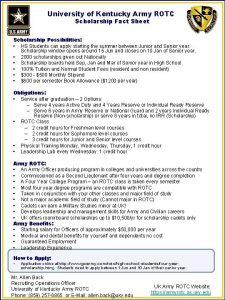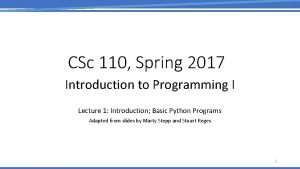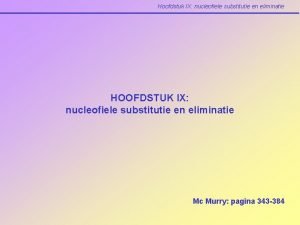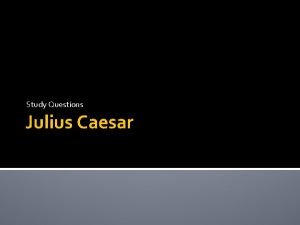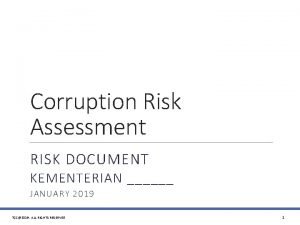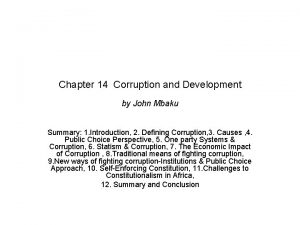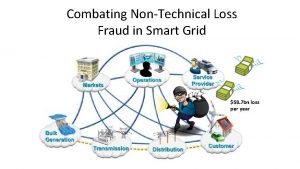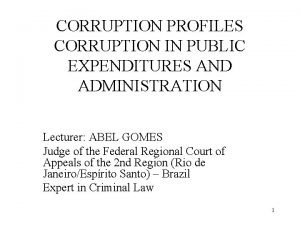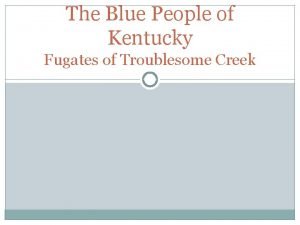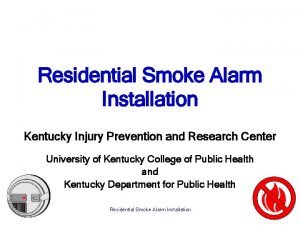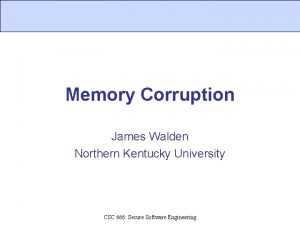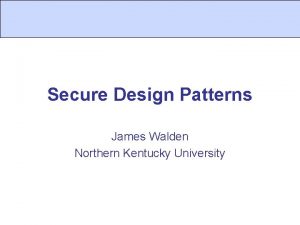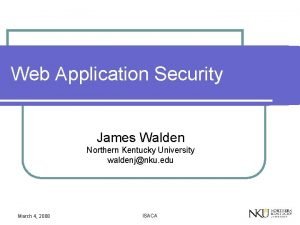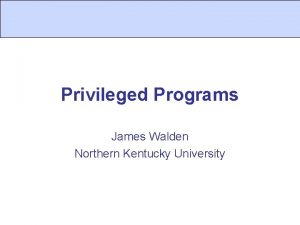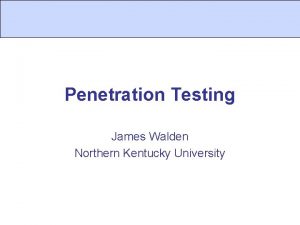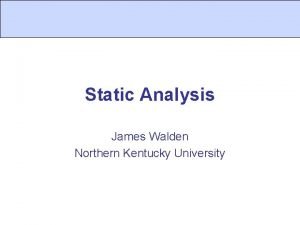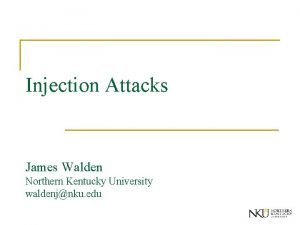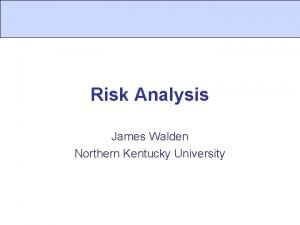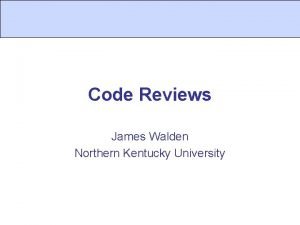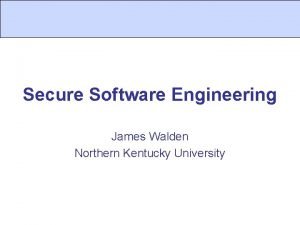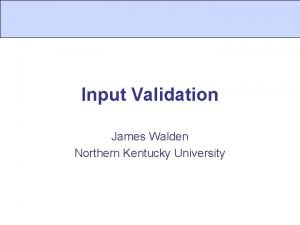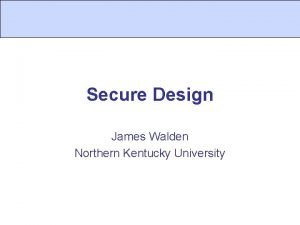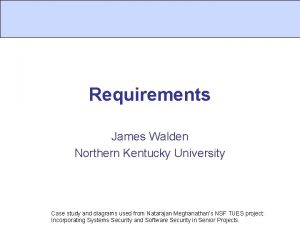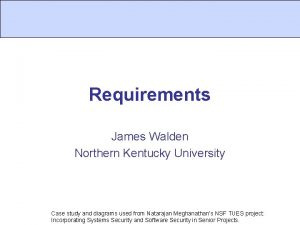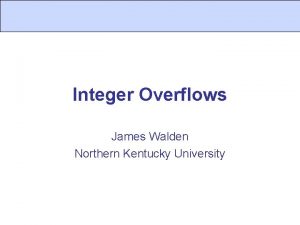Memory Corruption James Walden Northern Kentucky University CSC



![Buffer Overflows buffer: limited contiguously allocated set of memory. § static: char buffer[32] § Buffer Overflows buffer: limited contiguously allocated set of memory. § static: char buffer[32] §](https://slidetodoc.com/presentation_image_h/2cd11496edc9d49c390a985bdbf218e7/image-4.jpg)

![An Example Buffer Overflow char A[8]; short B=3; A A AA A A B An Example Buffer Overflow char A[8]; short B=3; A A AA A A B](https://slidetodoc.com/presentation_image_h/2cd11496edc9d49c390a985bdbf218e7/image-6.jpg)
![Out-of-Bounds Read What’s the mistake in this program? int main() { int array[5] = Out-of-Bounds Read What’s the mistake in this program? int main() { int array[5] =](https://slidetodoc.com/presentation_image_h/2cd11496edc9d49c390a985bdbf218e7/image-7.jpg)
![Out of Bounds Write Writing beyond the buffer: int main() { int array[5] = Out of Bounds Write Writing beyond the buffer: int main() { int array[5] =](https://slidetodoc.com/presentation_image_h/2cd11496edc9d49c390a985bdbf218e7/image-8.jpg)



![Memory Layout Example /* data segment: initialized global data */ int a[] = { Memory Layout Example /* data segment: initialized global data */ int a[] = {](https://slidetodoc.com/presentation_image_h/2cd11496edc9d49c390a985bdbf218e7/image-12.jpg)






















































![C++ Dangers Using C-style strings with cin char username[16]; cin >> username; The [] C++ Dangers Using C-style strings with cin char username[16]; cin >> username; The []](https://slidetodoc.com/presentation_image_h/2cd11496edc9d49c390a985bdbf218e7/image-67.jpg)



- Slides: 70

Memory Corruption James Walden Northern Kentucky University CSC 666: Secure Software Engineering

Topics 1. 2. 3. 4. 5. 6. 7. Buffer Overflows Stack Overflows Heap Overflows Use after Free Memory Corruption Mitigations Return Oriented Programming Writing Secure Code CSC 666: Secure Software Engineering

Memory Corruption Memory corruption occurs when contents of a memory location are modified in a way unintended by the programmer. Modifications can result from § Buffer overflows § Format string attacks (%n) § Use after free Memory corruption vulnerabilities can result in § § Execution of attacker-supplied code. Attacker hijacking of program control flow. Alteration of program data. Information leak. CSC 666: Secure Software Engineering
![Buffer Overflows buffer limited contiguously allocated set of memory static char buffer32 Buffer Overflows buffer: limited contiguously allocated set of memory. § static: char buffer[32] §](https://slidetodoc.com/presentation_image_h/2cd11496edc9d49c390a985bdbf218e7/image-4.jpg)
Buffer Overflows buffer: limited contiguously allocated set of memory. § static: char buffer[32] § dynamic: malloc(), new What happens when you attempt to access an element beyond the end of the buffer? § Bounds checking prevents such accesses in most languages like Python, Ruby, and Java. § But in C, C++, Objective C, Forth, and assembly large inputs can overflow the buffer, overwriting adjacent data in memory. CSC 666: Secure Software Engineering

C Strings § C strings terminated with � character. § Many operating systems and software components are written in C § Interfaces inherit semantic “strings end with �”. § Some components don’t handle � embedded in string gracefully, even if programming language can. § Note that UTF-16/UTF-32 include many byte 0 s. § Note that � takes space – account for it! § Overwriting can create string doesn’t end. § Formal name is NUL character H e l l o �
![An Example Buffer Overflow char A8 short B3 A A AA A A B An Example Buffer Overflow char A[8]; short B=3; A A AA A A B](https://slidetodoc.com/presentation_image_h/2cd11496edc9d49c390a985bdbf218e7/image-6.jpg)
An Example Buffer Overflow char A[8]; short B=3; A A AA A A B B 0 0 0 0 0 3 gets(A); A A A A B B o v e r f l o w s 0 CSC 666: Secure Software Engineering
![OutofBounds Read Whats the mistake in this program int main int array5 Out-of-Bounds Read What’s the mistake in this program? int main() { int array[5] =](https://slidetodoc.com/presentation_image_h/2cd11496edc9d49c390a985bdbf218e7/image-7.jpg)
Out-of-Bounds Read What’s the mistake in this program? int main() { int array[5] = {1, 2, 3, 4, 5}; printf("%dn", array[5]); } Program output: > gcc -o buffer. c >. /buffer 7077876 CSC 666: Secure Software Engineering
![Out of Bounds Write Writing beyond the buffer int main int array5 Out of Bounds Write Writing beyond the buffer: int main() { int array[5] =](https://slidetodoc.com/presentation_image_h/2cd11496edc9d49c390a985bdbf218e7/image-8.jpg)
Out of Bounds Write Writing beyond the buffer: int main() { int array[5] = {1, 2, 3, 4, 5}; int i; for( i=0; i <= 255; ++i ) array[i] = 41; } Program output: > gcc -o bufferw. c >. /bufferw Segmentation fault (core dumped) CSC 666: Secure Software Engineering

What happens when a buffer overflows? What happened to our buffer overflow? 1. Overwrote memory beyond buffer with 41. 2. Program crashed with Segmentation fault. 1. 2. 3. 4. Directly or indirectly accessed unmapped memory. Creates a page fault exception. OS does not find mapping on page table. OS sends segmentation fault signal to process. Do overflows always produce a crash? § Unintentional overflows usually do, but § Attackers will restrict writes to mapped pages. CSC 666: Secure Software Engineering

History of Overflows § § § § 1972: Computer Security Technology Planning Study. 1988: Morris Worm spreads with fingerd overflow. CERT formed. 1989: CERT published CA-1989 -01 for BSD 4. 3 passwd overflow. 1995: Thomas Lopatic posts info on httpd overflow to Bugtraq. 1996: Aleph One publishes “Smashing the Stack for Fun and Profit” 1997: Solar Designer describes return-to-libc technique. 1999: Compiler-based mitigations proposed. 2001: Code Red worm exploits overflow in IIS. 2003: Slammer worm infects every vulnerable server in an hour. 2004: AMD and Intel add non-executable bit in page tables. 2008: Twilight hack unlocks Wii consoles. 2010: Android 2. 3 adds support for non-exec stack. 2013: Unicode SSIDs crash i. Phones. 2015: GHOST overflow impacts glibc. CSC 666: Secure Software Engineering

Process Memory Map Lower-numbered addresses Used for global constants & variables me re o S g: ewhe red n i rn els be tom a m s W m -nu t bo ra er e g dia low at th w s sho resse d ad Higher-numbered addresses Text (compiled program code) Initialized global “data” Uninitialized global “data” Heap (dynamically allocated) Stack (procedure/ method calls) Often readonly Th is how diag Set on Inte stac ram s k h l code M some x 86 s s grow ows & g u load h lti-thre row o othe on ave ad the rs; mu ed p r wa y r ltip le s ogram. tac ks s Heap grows, e. g. , due to “new” or malloc() Heap pointer Stack pointer (SP) (current top of stack) Stack grows, e. g. , 11 due to procedure call
![Memory Layout Example data segment initialized global data int a Memory Layout Example /* data segment: initialized global data */ int a[] = {](https://slidetodoc.com/presentation_image_h/2cd11496edc9d49c390a985bdbf218e7/image-12.jpg)
Memory Layout Example /* data segment: initialized global data */ int a[] = { 1, 2, 3, 4, 5 }; /* bss segment: uninitialized global data */ int b; /* text segment: contains program code */ int main(int argc, char **argv) /* ptr to argv */ { /* stack: local variables */ int *c; /* heap: dynamic allocation by new or malloc */ c = (int *)malloc(5 * sizeof(int)); } CSC 666: Secure Software Engineering

Abstract data type “Stack”: Abstract CS concept – “A stack of objects has the property that the last object placed on the stack will be the first object removed. This property is commonly referred to as last in, first out queue” (LIFO). Minimum stack operations: – PUSH: Add an element to the top of the stack – POP: Removes the last element at the top of the stack (returning it) and reduces stack size by one. CSC 666: Secure Software Engineering

“Stack” in process memory map Memory area set aside to implement calls to a procedure/function/method/subroutine For now we’ll use these terms interchangeably In C the term is “function” Stack is used to implement control flow When you call a procedure, where it “came from” is pushed on stack When a procedure returns, the “where I came from” is popped from stack; system starts running code there Stack also used for other data (in many cases) Parameters passed to procedures Procedure local variables Return values from procedure CSC 666: Secure Software Engineering

Call Stack Layout b() { … } a() { b(); } main() { a(); } Low Memory Unallocated Stack Frame for b() Stack Frame for a() Stack Frame for main() High Memory CSC 666: Secure Software Engineering

What is a Stack Frame? Block of stack data for one procedure call. Frame pointer (FP) points to frame: – Use offsets to find local variables. – SP continually moves with push/pops. – FP only moves on function call/return. – Intel CPUs use %ebp register for FP. CSC 666: Secure Software Engineering

Why use stacks for function calls? First compiled languages (e. g. , FORTRAN) did not use stacks Call data stored with fn where program “came from” Result: Procedures could not call themselves, directly or indirectly, as that would overwrite stored information. If functions can arbitrarily call other functions Need to store old state so can return back Need dynamic allocation for call (frame) sequences Stack is flexible & efficient CSC 666: Secure Software Engineering

CPUs track two stack values Stack pointer (SP): Value of “top” of stack – Where last data was stored on stack, possibly +/1 depending on architecture conventions – Modified when data pushed/popped • May even be modified during expression calculation Frame pointer (FP): Value of “this frame” – Simplifies accessing parameters & local variables – Points inside stack to where “this procedure” starts – Modified on entry/exit of a procedure CSC 666: Secure Software Engineering

Accessing the Stack Pushing an item onto the stack. 1. Copy 4 bytes of data to stack. 2. Decrement SP by 4. Example: pushl $12 Popping data from the stack. 1. Copy 4 bytes of data from stack. 2. Increment SP by 4. Example: popl %eax Retrieve data without pop: movl %esp, %eax CSC 666: Secure Software Engineering

Calling a procedure Given this C program: void main() { f(1, 2, 3); } The invocation of f() might generate assembly: pushl $3 ; constant 3 pushl $2 ; Most C compilers push in reverse order by default pushl $1 call f “call” instruction pushes instruction pointer (IP) on stack – In this case, the position in “main()” just after f(…) – Saved IP named the return address (RET) – CPU then jumps to start of “function” CSC 666: Secure Software Engineering

Stack: After push of value 3 Lower-numbered addresses Higher-numbered addresses 3 Stack pointer (SP) (current top of stack)

Stack: After push of value 2 Lower-numbered addresses Higher-numbered addresses 2 3 Stack pointer (SP) (current top of stack) Stack grows, e. g. , due to procedure call

Stack: After push of value 1 Lower-numbered addresses Higher-numbered addresses 1 2 3 Stack pointer (SP) (current top of stack) Stack grows, e. g. , due to procedure call

Stack: Immediately after call Lower-numbered addresses Higher-numbered addresses Return address in main() 1 2 3 Stack pointer (SP) (current top of stack) Stack grows, e. g. , due to procedure call

Function prologue Imagine f() has local variables, e. g. in C: void f(int a, int b, int c) { char buffer 1[5]; char buffer 2[10]; strcpy(buffer 2, "This is a very long string!!!!!!!"); } Typical x 86 -32 assembly on entry of f() (“prologue”): pushl %ebp ; Push old frame pointer (FP) movl %esp, %ebp ; New FP is old SP subl $20, %esp ; New SP is after local vars ; “$20” is calculated to be >= local var space In the assembly above, “; ” introduces a comment to end of line CSC 666: Secure Software Engineering

Stack: Immediately after call Lower-numbered addresses Higher-numbered addresses Return address in main() 1 2 3 Stack pointer (SP) (current top of stack) Stack grows, e. g. , due to procedure call

Stack: After prologue Lower-numbered addresses Stack pointer (SP) (current top of stack) Local array “buffer 2” Higher-numbered addresses Local array “buffer 1” Saved (old) frame pointer Return address in main() 1 2 3 Frame pointer (FP) – use this to access local variables & parameters Stack grows, e. g. , due to procedure call

Stack: Overflowing buffer 2 Lower-numbered addresses Stack pointer (SP) (current top of stack) Local array “buffer 2” Overwrite Local array “buffer 1” Saved (old) frame pointer Return address in main() 1 2 Higher-numbered addresses 3 Frame pointer (FP) – use this to access local variables & parameters Stack grows, e. g. , due to procedure call

Effect of Overflowing Buffer 2 Overwrites whatever is past buffer 2! § As you go further, overwrite higher addresses Impact depends on system details In our example, can overwrite: § § § Local values (buffer 1) Saved frame pointer Return value (changing what we return to) Parameters to function Previous frames CSC 666: Secure Software Engineering

Common buffer overflow attack § Send too large data as user input. § Overlarge data overwrites buffer § Modifies return value, to point to something the attacker wants us to run § Maybe with different parameters, too § On return, runs attacker-selected code § But it gets worse… CSC 666: Secure Software Engineering

Shellcode Injection § Attacker can also include machine code that they want us to run. § If they can set the “return” value to point to this malicious code, on return the victim will run that code § Unless something else is done § Significant portion of “Smashing the Stack” paper describes how to insert such code. CSC 666: Secure Software Engineering

Stack: Overflow with Shellcode Lower-numbered addresses Malicious code Stack pointer (SP) (current top of stack) Local array “buffer 2” Higher-numbered addresses Local array “buffer 1” Saved (old) frame pointer Return address in Ptr to malicious code main() 1 2 3 Frame pointer (FP) – use this to access local variables & parameters Stack grows, e. g. , due to procedure call

Stack: Shellcode + NOP Sled Lower-numbered addresses NOP sleds let attacker jump anywhere to attack; real ones often more complex (to evade detection) Shellcode often has odd constraints, e. g. , no byte 0 Higher-numbered addresses Stack pointer (SP) (current top of stack) NOP sled: x 90x 90…. Local array “buffer 2” Shellcode: xebx 1 fx 5 ex 89x 76x 08x 31xc 0x 88x 46 x 07x 89x 46x 0 cxb 0x 0 bx 89xf 3x 8 dx 4 ex 08x 8 dx 56x 0 cxcdx 80x 31xdbx 89xd 8x 40xcdx 80xe 8xdcxffxff/bin/sh Local array “buffer 1” Saved (old) frame pointer Return address in Ptr to malicious code main() 1 2 3 Frame pointer (FP) – use this to access local variables & parameters Stack grows, e. g. , due to procedure call

Shellcode § Shellcode is a small piece of machine code inserted into a program by exploiting a vulnerability. § Called shellcode since it is often used to start a command shell under control of attacker. § Example shellcode § § Remote shell (like ssh) Reverse shell (opens connection to attacker server) Remote desktop (RDP, VNC, etc. ) Downloader (installs remote control tools) CSC 666: Secure Software Engineering

Off-by-One Overflows Even 1 byte overflow can allow attacker to control execution by overwriting low order byte of FP. CSC 666: Secure Software Engineering

Heap Overflows Programs allocate memory on heap via § C: malloc() and free() § C++: new and delete To run shellcode, attack overwrites function pointer § Function pointers in C. § C++ methods implemented as function pointers. § C++ exceptions result in following a function pointer. CSC 666: Secure Software Engineering

Memory Allocation § Memory allocators typically § § § Allocate memory in chunks. Chunks stored in a linked list of bins. Chunks contain header, pointers, and data. Each bin contains chunks of a specific size. Final chunk contains free space information. § Memory corruption attacks target § Header information, and § Pointers. CSC 666: Secure Software Engineering

Malloc Data Structure CSC 666: Secure Software Engineering

Malloc Example char *a, *b, *c; a = malloc(32) b = malloc(32); c = malloc(32); … free(c) free(b) free(a) CSC 666: Secure Software Engineering

Malloc Example Memory Layout CSC 666: Secure Software Engineering

Malloc Layout after Free CSC 666: Secure Software Engineering

Overflowing Dynamic Buffers CSC 666: Secure Software Engineering

Overwriting vtable Pointers CSC 666: Secure Software Engineering

free() vulnerabilities § To de-allocate memory, free(void *) must § Use pointer to find chunk to de-allocate. § Modify pointers in chunk header to remove chunk from the list of in-use chunks. § Loop: if adjacent chunk is free, combine chunks to avoid memory fragmentation. § To exploit free(), an attacker can § Overwrite adjacent chunk metadata. § Cause free() to overwrite a specific word in memory with attacker specified data. § Attacker will choice location to be that of a pointer (lib function, vtable ptr, ret addr, etc. ) to control execution. CSC 666: Secure Software Engineering

Double free() vulnerability 1. Program free()s chunk twice, so chunk appears twice in the free list. 2. Program allocates memory, reusing part or all of chunk. § § malloc() interprets first bytes as free list header. Program interprets first bytes as data. 3. Write to allocated chunk, changing first bytes. 4. Program allocates, attempts to reuse chunk. § malloc() writes to location specified in first bytes, treating bytes as free list pointer, but those bytes now point to any location specified by attacker. CSC 666: Secure Software Engineering

Non-executable Stack § Memory protection prevents code on the stack from being executed. § Adds NX permission bit to page tables. § Required CPU and OS modifications. § Limitations § Some applications need to execute code on the stack (JIT compilers for Java, Java. Script). § Attackers can target other areas of memory. § Buffer overflows can result in remote code execution without running attacker generated shellcode.

Address Space Randomization § ASLR randomly changes code/data locations to prevent memory exploits. § Problems § Code must be compiled as Position Independent Executables (PIE) to relocate code segment at cost of a 10% performance penalty. § Memory corruption can result in information leakage of address layout. § Attackers can brute force 32 bit ASLR with many copies of shellcode (heap-spraying). CSC 666: Secure Software Engineering

Canary Defenses Compiler changes calling convention in two ways: – Adds a canary word to the stack (“canary in a coal mine”) – Verifies presence of canary word before executing the ret instruction to return to address on stack. Protects against stack smashing since – Overflow would have to overwrite canary to reach return value. – If canary is chosen randomly, attacker cannot know what to overwrite to that memory location. – Does not protect against indirect memory writes. CSC 666: Secure Software Engineering

Canary Stack Layout old frame param 1 param 2 old PC canary word old FP local vars Frame Pointer Stack Pointer CSC 666: Secure Software Engineering

Return-Oriented Programming ROP is an exploit technique in which the attacker gains control of the call stack and uses it to execute small pieces of code, called “gadgets. ” – Attacker uses existing code. – Bypasses NX defense, since no new code executed. Gadgets are typically found in shared libraries – Gadgets can be entire functions. – Gadgets can be fragments of code that end in a ret instruction (even unintentional instructions. ) – Attacker controls order of execution and parameters by placing data on call stack. CSC 666: Secure Software Engineering

Normal Programming § Instruction pointer (%eip) determines which instruction to fetch and execute. § CPU automatically increments %eip to next instruction. § Control flow by modifying %eip. CSC 666: Secure Software Engineering

Return Oriented Programming • Stack pointer (%esp) determines which instruction sequence to fetch and execute. • Move to next sequence after ret instruction. CSC 666: Secure Software Engineering

Finding Gadgets § Intel x 86 assembly is dense § Instructions are of variable length. § Instruction pointer can point to any location. § As a result § Any byte c 3 is a ret instruction. § By pointing %eip into the middle of a long instruction, part of that instruction can be executed as a different instruction or set of instructions. CSC 666: Secure Software Engineering

Unintended Instructions Example CSC 666: Secure Software Engineering

Writing Overflow Free Code 1. Know which functions are § Unsafe: guaranteed buffer overflow. § Safe: no overflow if arguments correct. 2. Know how to use safe functions securely. 3. Do your own bounds checking. § Be careful to avoid integer overflows. 4. Check for memory errors § Security-oriented static analysis like Fortify. § Memory dynamic analysis: Valgrind, Purify. CSC 666: Secure Software Engineering

Many C fns don’t check bounds § gets(3) – reads input without checking. Don’t use it! § strcpy(3) – strcpy(dest, src) copies from src to dest § If src longer than dest buffer, keeps writing! § strcat(3) – strcat(dest, src) appends src to dest § If src + data in dest longer than dest buffer, keeps writing! § scanf() family of input functions – many dangerous § scanf(3), fscanf(3), sscanf(3), vsscanf(3), vfscanf(3) § Many options don’t control max length (e. g. , bare “%s”) § Many other dangerous functions, e. g. : § realpath(3), getopt(3), getpass(3) § streadd(3), strecpy(3), and strtrns(3) § It’s not just functions; ordinary loops can overflow.

gets() CSC 666: Secure Software Engineering

strcpy() CSC 666: Secure Software Engineering

sprintf() CSC 666: Secure Software Engineering

Bounded Function Pitfalls 1. Destination buffer overflows because bound depends on size of source data, not destination buffer. 2. Destination buffer left without null terminator, often as result of off-by-one error. 3. Destination buffer overflows because its bound is specified as the total size of the buffer, rather than space remaining. 4. Programs writes to arbitrary location in memory as destination buffer is not null-terminated and function begins writing at location of first null in destination buffer. CSC 666: Secure Software Engineering

C 11 Annex K Bounds Checking C 11 standard adds bounds-checking interfaces Creates “safer” versions of C functions Limits lengths of results Example: strcpy_s(s 1, s 1 max, s 2); Copies s 2 to s 1 max > strnlen_s(s 2, s 1 max) Does not automatically resize. On error, calls runtime-constraint handler function, controlled by set_constraint_handler_s(). This handler can permit returns If it returns, returns 0 if ok, nonzero if a constraint failed Not universally available. Provided by slibc. CSC 666: Secure Software Engineering

Safe String Libraries strlcat() and strlcpy() – BSD-licensed open source routines C++ std: : string library – Dynamically-sized strings Safe. Str library provides safestr_t objects – Dynamically-sized – Cast to (char *) for read-only purposes only Microsoft’s strsafe. h CSC 666: Secure Software Engineering

Safe String Libraries UNIX Libraries C Bstrlib MT-Safe. Str strlcpy(), strlcat() Vstr C++ std: : string (STL) Windows Libraries C Safe CRT strlcpy(), strlcat() Str. Safe C++ CString (MFC) Safe C++ std: : string (STL) CSC 666: Secure Software Engineering

strlcpy() and strlcat() size_t strlcpy (char *dst, const char *src, size_t size); size_t strlcat (char *dst, const char *src, size_t size); § Size is max size of dest buffer (not maximum number of chars to copy), including NULL. § Destination buffer always NULL terminated § Return how much space would be required in destination buffer to perform operation. § BSD-style open source license. CSC 666: Secure Software Engineering

Character Sets Characters represented using encoding forms that map code points to printable chars. § Fixed Width § ISO-8859 -1 § UTF-32 § Variable Width § UTF-8 (most Internet protocols, Python, Ruby) § UTF-16 (Java, . NET) Character Encoding Code Point s ISO-8859 -1 UTF-8 73 73 ÿ ISO-8859 -1 UTF-8 FF C 3 BF CSC 666: Secure Software Engineering

Wide Characters C/C++ § char contains 1 -byte characters § wchar_t is 2 -byte, 4 -byte on some platforms Java and. NET strings § UTF-16 encoding Buffer Overflow issues § Mixing up different character-set string types. § Are sizes measured in bytes or characters? CSC 666: Secure Software Engineering
![C Dangers Using Cstyle strings with cin char username16 cin username The C++ Dangers Using C-style strings with cin char username[16]; cin >> username; The []](https://slidetodoc.com/presentation_image_h/2cd11496edc9d49c390a985bdbf218e7/image-67.jpg)
C++ Dangers Using C-style strings with cin char username[16]; cin >> username; The [] operator does not perform bounds checking Converting from C++ to C-style strings • string: : data() output is not NULL terminated • string: : c_str() ouput is NULL terminated CSC 666: Secure Software Engineering

Key Points 1. Memory corruption vulnerabilities can result in § § Execution of attacker-supplied code. Attacker hijacking of program control flow. Alteration of program data. Information leak. 2. Memory Corruption Attack Types § Buffer overflows: stack and heap § Format string attacks (%n) § Use after free CSC 666: Secure Software Engineering

Key Points (2) 3. Mitigations § Non-executable Stack (OS, hardware) § Address Space Layout Randomization (OS) § Stack Canaries (compiler) 4. Countering Mitigations § Brute force (heap spraying) § Return Oriented Programming 5. Writing Secure Code § Avoiding unsafe functions. § Performing bounds checking. CSC 666: Secure Software Engineering

References 1. 2. 3. 4. 5. 6. 7. 8. 9. 10. 11. Aleph Null, “Smashing the Stack for Fun and Profit, ” Phrack 49, 1996. Erik Buchanan et al. , “Return-Oriented Programming: Exploits Without Code Injection”, https: //cseweb. ucsd. edu/~hovav/talks/blackhat 08. html, 2008. Johnathan Bartlett, Programming from the Ground Up, Bartlett Publishing, 2004. James C. Foster et al. , Buffer Overflow Attacks, Syngress, 2005. Scot Hand, Heap Based Exploitation, https: //csg. utdallas. edu/wpcontent/uploads/2012/08/Heap-Based-Exploitation. pdf, 2012. Koziol et al. , The Shellcoder’s Handbook: Discovering and Exploiting Security Holes, Wiley, 2004. Haroon Meer, “History of Memory Corruption Attacks”, http: //media. blackhat. com/bh-us-10/whitepapers/Meer/Black. Hat-USA-2010 -Meer. History-of-Memory-Corruption-Attacks-wp. pdf, 2010. Tom Plum, “The New C Standard Explored”, http: //www. drdobbs. com/cpp/the-newc-standard-explored/232901670, Dr. Dobb’s Journal, 2012. Robert C. Seacord, Secure Coding in C and C++, Addison-Wesley, 2006. Laszlo Szekeres et al. "Eternal war in memory. " Proceedings of the 34 th IEEE Symposium on Security and Privacy (SP’ 13), San Francisco, CA. 2013. John Viega and Gary Mc. Graw, Building Secure Software, Addison-Wesley, 2002. CSC 666: Secure Software Engineering
 James walden md
James walden md Walden university fnp
Walden university fnp Walden university
Walden university University of kentucky disability resource center
University of kentucky disability resource center Worcester state university notable alumni
Worcester state university notable alumni Eastern kentucky flights
Eastern kentucky flights University of kentucky axolotl
University of kentucky axolotl University of kentucky study abroad programs
University of kentucky study abroad programs Ukcom curriculum
Ukcom curriculum Uky rotc
Uky rotc Csc 110 university of arizona
Csc 110 university of arizona Walden inversie
Walden inversie Walden ultrasound
Walden ultrasound Kirk walden
Kirk walden Walden mla citation
Walden mla citation Walden iop
Walden iop Graduate college arizona
Graduate college arizona Northern arizona university blackboard
Northern arizona university blackboard James russell odom
James russell odom James russell odom
James russell odom Why do the conspirators plant papers on brutus’s chair?
Why do the conspirators plant papers on brutus’s chair? Locus of corruption
Locus of corruption La corruption conclusion
La corruption conclusion Corruption risk assessment
Corruption risk assessment Corruption risk assessment matrix
Corruption risk assessment matrix Conclusion of corruption
Conclusion of corruption Anti-corruption efforts
Anti-corruption efforts The great gatsby chapter 3 summary
The great gatsby chapter 3 summary The great gatsby summary
The great gatsby summary Exposé sur la corruption
Exposé sur la corruption Fraud and corruption analaytics
Fraud and corruption analaytics Types of coruption
Types of coruption Lesson 3 corruption plagues the nation
Lesson 3 corruption plagues the nation Corruption in the church during the reformation
Corruption in the church during the reformation Corruption plagues the nation
Corruption plagues the nation Corruption in the catholic church
Corruption in the catholic church Ddo combating corruption
Ddo combating corruption Uk bribery act training slides
Uk bribery act training slides Infant development
Infant development Corruption
Corruption Corruption
Corruption Great gatsby chapter 3 and 4 quotes
Great gatsby chapter 3 and 4 quotes Conclusion for corruption
Conclusion for corruption Corruption essay conclusion
Corruption essay conclusion Police introduction
Police introduction Researching the corruption
Researching the corruption The great gatsby ch 3 summary
The great gatsby ch 3 summary Corruption quiz
Corruption quiz Macbeth corruption
Macbeth corruption William james memory
William james memory Prototype in semantics
Prototype in semantics Implicit memory vs explicit memory
Implicit memory vs explicit memory Long term memory vs short term memory
Long term memory vs short term memory Internal memory and external memory
Internal memory and external memory Primary memory and secondary memory
Primary memory and secondary memory Logical versus physical address space
Logical versus physical address space Which memory is the actual working memory?
Which memory is the actual working memory? Page fault
Page fault Virtual memory in memory hierarchy consists of
Virtual memory in memory hierarchy consists of Eidetic memory vs iconic memory
Eidetic memory vs iconic memory Shared vs distributed memory
Shared vs distributed memory James madison university rotc
James madison university rotc James walsh brown university
James walsh brown university 詹景裕
詹景裕 Grand lodge of kentucky
Grand lodge of kentucky Kentucky tornado alley
Kentucky tornado alley Kentucky glow caverns
Kentucky glow caverns How to scarify kentucky coffee tree seeds
How to scarify kentucky coffee tree seeds Blue people fugates
Blue people fugates Smoke detector mounting tape
Smoke detector mounting tape Kenya stump kentucky
Kenya stump kentucky









